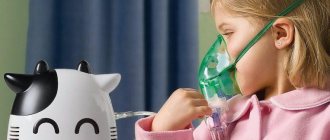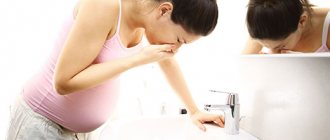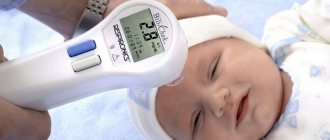Vomiting and fever in a child can occur for various reasons. These symptoms require an immediate visit to the doctor. A common cause of this condition is intestinal infections. If help is not provided in time, severe dehydration can occur. An adult will endure this condition steadfastly, but for a child this state of affairs is critical.
Defense Mechanisms
The first thing you need to understand is that both vomiting and a temperature of about 37 degrees in a child are protective mechanisms coordinated by the hormonal, immune and nervous systems.
Vomiting is the release of stomach contents through the mouth, activated by irritation of the vomiting receptors of the throat, esophagus, stomach wall and other organs, if further digestion of food poses a potential threat. In addition, vomiting can be triggered by emotional stress. It is believed that in this way a person is freed from “extra burden” and can direct all his energy to salvation in a dangerous situation.
At the same time, an increase in body temperature to 37-38 degrees activates the body’s defenses - it accelerates the synthesis of immune proteins, increases the speed of blood circulation and prevents pathogenic microorganisms from multiplying. At the same time, in a child aged 1 to 3 years, vomiting can be the result of an increase in temperature, and vice versa. This occurs due to the immaturity of the gastrointestinal tract and thermoregulation processes in the first years of life.
Remember that suppressing the urge to vomit and reducing fever in the first 2-3 hours of illness is not recommended.
Moreover, if you are sure that the child is vomiting and has a high fever as a result of poisoning, help his body cleanse itself of toxins. What should I do for this? Let's drink a lot of water, you can even artificially induce a cleansing of the stomach by influencing the gag reflex receptors (at the root of the tongue).
Vegetovascular dystonia
Vegetative-vascular dystonia includes many symptoms that indicate a disruption of the autonomic system. Dystonia leads to disruption of the thyroid gland, heart and blood vessels, and also impairs the functions of the digestive, respiratory and circulatory systems . With vascular dystonia, the following disorders are observed:
- frequent headache;
- abnormal sleepiness;
- loss of appetite;
- nausea and vomiting;
- pale skin;
- dizziness;
- atypical sweating;
- low pressure;
- decrease in temperature.
In addition, a child suffering from VSD often experiences fainting and darkening of the eyes . If any of these symptoms appear, the child is examined by a cardiologist and neurologist.
Danger of condition
As we have already found out, if a child is vomiting and has a temperature of 37, we need to optimize the detoxification process. Is this condition in itself dangerous? The answer is definitely yes.
Negative effects of vomiting and hyperthermia:
- Children, especially infants, may choke on vomit. This happens if food debris gets into the trachea. Lying down increases the risk of choking. Fever and vomiting in infants are often interrelated and flow into each other. To avoid vomit getting into the respiratory tract, place the child semi-upright, place the head higher, and tilt it slightly to the side.
- If a child is nauseous and the temperature rises to 38 degrees, his body rapidly loses water (with vomiting, sweat). Dehydration is the most striking negative effect of poisoning. It is necessary to constantly replenish fluid reserves in the body - often drink water and tea. It is better to avoid milk (does not apply to infants).
- Hyperthermia can get out of control. If the readings reach 39 degrees, it is better to take an antipyretic drug. For children who have problems with the heart or nervous system, prone to convulsions or delirium tremens, antipyretics are given when thermometry readings are 38.5 C or higher.
- If the vomiting is so strong and frequent that the child cannot eat or drink, there is a danger of exhaustion. In this case, medical attention is needed.
That is why it is very important to monitor the condition of a sick child - measure body temperature, monitor the color and amount of vomit, and the frequency of urges. You should not leave a child with intoxication alone.
Signs of dehydration
Dehydration is a condition of the body in which the amount of fluid becomes much less than normal physiological indicators.
Dehydration can be recognized by the following signs:
- The skin becomes dry and pale.
- There is rapid loss of body weight.
- A newborn baby may experience retraction of the fontanel.
- The viscosity of saliva increases.
- The amount of urine excreted decreases. Urine becomes dark.
- Dry mouth.
With severe dehydration, uncontrollable vomiting may appear, dry areas on the oral mucosa are clearly visible, there is a complete lack of elasticity of the skin, weight loss is greatly reduced, the extremities become cold, and acquire a bluish tint.
Expert opinion
Ksenia Dunaeva
User experience expert and comment moderator. Higher medical education and more than 5 years of actual practice.
Ask Ksenia
When faced with signs of dehydration, it is important to seek medical help as soon as possible. This condition is especially dangerous for infants. Without medical help, severe complications can develop, including paralysis and death.
Call a doctor
When vomiting is one-time, the temperature does not rise above 37, there is no reason to call an ambulance. Adults monitor the baby's condition. The child is cheerful, cheerful, has not lost his appetite - there is no reason to panic. In the first few months of life, vomiting in a baby may be a sign of inadequate development of the gastrointestinal tract, a peculiar adaptation of the body to new food. Eating large amounts of food, motion sickness, and air getting in with food provokes vomiting.
Symptoms that require calling a doctor:
- repeated vomiting;
- dehydration, inability to drink water due to vomiting;
- the appearance of other symptoms at a temperature above 39;
- lethargy, weakness, deterioration;
- the presence of blood with vomiting, feces;
The child’s life depends on the speed of the parents’ reaction.
What to do if a child feels sick and the temperature does not subside for a long time, despite the efforts of the parents? You may need medical help.
You need to call an ambulance if:
- you know for certain or you suspect that the child has eaten a toxic substance (poison for insects, rodents, dishwashing detergent, medications);
- vomiting and fever in a child is a response to the treatment of any disease prescribed by a doctor, and taking medications is impossible;
- the urge is so frequent that it is impossible to give the patient something to drink;
- thermometry readings rose above 39 degrees;
- there is no food in the vomit, but only gastric juice, or it contains blood impurities;
- the child has a rash on his body;
- the patient is in a semi-conscious state, delirious;
- the symptoms have not subsided for 12 hours.
Remember that many of the possible illnesses that cause vomiting and fever are life-threatening. It is better to consult with doctors once again than to risk the health of the child.
What to do if a child is vomiting without fever or diarrhea: first aid for parents
What to do if a person starts vomiting and the body temperature rises? It is necessary to try to help him - to improve his well-being, reduce the likelihood of complications and speed up the process of cleansing the body.
1. Do not block the processes of eliminating toxins (vomiting, diarrhea and fever) in the first hours of the development of the disease.
2. If you are sure that the child has eaten a low-quality product or an inedible substance, but there is no vomiting, it is necessary to artificially induce them. At the same time, be sure to drink a lot of water, preferably alkaline mineral water, or just boiled with a pinch of soda.
3. You should not take any medications before the doctor examines the patient and makes a diagnosis. The exception is sorbents (activated carbon, enterosgel, etc.).
4. You need to drink often, in small portions, since a large volume of liquid drunk will provoke another cleansing of the stomach, and the body will not have time to absorb the liquid.
5. It is better to refuse food for several hours. When the child gets better, he will ask for food himself. You should start with small portions of light food; fatty and fermented milk products are temporarily prohibited.
6. If there is a need to bring down a fever (38.5-39 C), give preference to rectal suppositories, because the stomach may refuse to take pills or syrups.
7. Monitor your child’s well-being. If there is no improvement within 12 hours, call the pediatrician - the causes of vomiting and fever in a child are often fatal diseases.
We remind you that vomiting is a defensive reflex of the body. Moreover, all children's systems are more susceptible to external or even internal factors. As practice shows, vomiting in a child without fever and diarrhea can have both a serious threat and a not very catastrophic form in its consequences.
- The first thing that is required of you is to provide everything you need. That is, peace and a small pelvis. By the way, do not try to stop your baby from vomiting. After all, this is how our system tries to get rid of toxins and poisons. This is how the body cleanses itself.
- Lay your baby on his side or turn only his head. Place a cushion under your head so that your head is slightly elevated, about 30°. Even if trouble happens to a teenager, do not leave him unattended. Make sure your child does not choke on vomit.
Place your baby on his side and do not leave him unattended
- If the child is old enough, then ask, perhaps he ate something without your knowledge. Young children need to be monitored very carefully, because they can swallow a part from a toy or a small element. And this will also cause vomiting without diarrhea and fever.
- Naturally, help your baby in the right situation and be sure to wipe the lips and corners of the mouth with a damp cloth, and rinse the oral cavity with clean warm water. If the baby is vomiting without fever or diarrhea, then simply wipe with a wet sponge. It will not be superfluous if you use a weak solution of boric acid or potassium permanganate.
- Pay attention to the vomit itself. This will help the doctor diagnose the disease. That is, liquid, thick, slimy, or with any impurities. Frequency also matters. So watch and remember.
- Eliminate the use of medications at your own discretion! They are contraindicated for children in such a situation until a doctor arrives or an ambulance arrives. Once again, let’s make a reservation that this is how the body gets rid of unnecessary substances. The maximum you can give is enterosorbents (that is, preparations like activated carbon).
- You can give him water at room temperature to drink. But start with one spoon! It happens that water also causes vomiting. And after a while, when the body has not rejected the liquid, you can give it more. And remember - no soda. Only boiled plain water, no sugar or jam.
- Also arm yourself with the following scheme: give one-year-old babies 2 tsp every 5 minutes. warm water, up to 3 years, increase the dose to 3 tsp, and after 3 years, give 4-5 tsp.
Give water in small portions and gradually
- In case of typical poisoning, the stomach should be rinsed immediately. To do this, first give your child a glass of liquid to drink. Preferably with activated carbon. After 10-15 minutes, when the sorbent has begun to act a little, induce vomiting. You do this by pressing on the upper tongue with two fingers or a spoon. But don't push too hard. In general, this should be done until the water coming out is clear. But this is very difficult to do with small children. After such procedures, give the required amount of coal.
- If you notice that the baby did not just burp, but vomited, then immediately rush to the doctor or call him at home. No measures other than supervision are required from you. Infants and children under one year of age are prohibited from giving any medications.
- If a foreign object is found in the child’s esophagus or he himself indicates that he has swallowed something, it is advisable to immediately consult a doctor. Do not try to get the item yourself; let specialists do it. You can only make it worse!
- If you notice that vomiting was caused by the body’s reaction to a certain product, then you should immediately exclude it from the diet. This phenomenon is common in infants when they begin to feed or change the type of complementary foods. In the future, after reaching a certain permitted age, we advise you to give your child samples for allergens.
Pay attention to any accompanying symptoms or the slightest changes in the body
- If you experience vomiting without fever and diarrhea after taking medications, we advise you to immediately contact your pediatrician. You may need to be tested for allergens in order to eliminate them in the future and replace the medicine.
- Sometimes such vomiting can be caused by a strong cough. After all, during a cough, the entire mucous membrane is greatly irritated. We recommend that it is better not to treat the child at home, but to conduct an examination in a specialized institution. And carry out further treatment only as prescribed by your doctor. Since a fairly common symptom of whooping cough is vomiting without other accompanying factors when coughing. Keep this in mind!
- Of course, it sounds strange, but now many people are faced with vomiting without fever and diarrhea precisely when their child has a cold. The fact is that when the nose is very stuffy with a large amount of nasal mucus, it is difficult for the child to breathe. Moreover, small children do not yet know how to clear their nasal passages. Therefore, the body tries to get rid of the problem naturally. In such cases, it is necessary to treat not vomiting, but a cold and, especially, a stuffy nose.
- If vomiting began after hitting your head, this may indicate a concussion. The child must be urgently taken to the hospital for further examination! Parents are only required to act quickly and be attentive so that the child does not choke.
In any case, take your child to the doctor
- It may be difficult for a child to swallow a charcoal tablet, so give preference to medications that need to be diluted in water. For example, Smecta, Atoxil, Enterosgel.
- To restore electrolytes, if vomiting does not recur or the cause has been eliminated, give drugs such as Regidron, Glucosolan and analogues. The bag should be diluted in 1 liter of water, gradually giving the patient 1-2 tsp. in 6-8 hours.
- Try to put babies to your breast more often. For older children, at first, exclude dairy products and focus on cereals and broths.
You can give the following folk remedies that will help reduce nausea:
- Chamomile tea, which is suitable for any age. A small addition of sugar is allowed if the baby refuses to drink water;
- mint or lemon balm tea. These herbs also relieve nausea, soothe the mucous membranes and improve general condition;
- decoction of dill seeds. It’s very easy to prepare – just add 1 tsp. 200 ml of boiling water and leave under a saucer until it cools. Give 1 tbsp warm. l. every 30 minutes;
- Prepare ginger water using the same principle and dosage. Leave for 10 minutes, add lemon juice and a spoonful of honey and give 1-2 tsp.
We have given you the main causes of vomiting without fever and diarrhea, as well as the appropriate options for the necessary actions on your part. But always seek professional help. Self-medication quite often has disastrous consequences. And a child’s body is weak enough for additional diseases.
What not to do
If the child’s condition is not critical, you don’t have to call an ambulance, but leave a request for a pediatrician to come. At the same time, the baby must drink. And the mother should make sure that the temperature is low, the stool is normal, and there is no pain in the abdomen or head. Only after this can you continue treatment at home. This must be done very carefully, adhering to the basic rules:
- If there is stool in the form of diarrhea, then you cannot block it for the first few hours after the onset. The same goes for vomiting. It is necessary to allow the body to get rid of unnecessary and harmful toxins. Especially if the cause of such symptoms is an intestinal infection or poisoning.
- Before the doctor arrives, you should not give your child any medications. Only after identifying the disease can truly effective therapy begin. The maximum that a mother can do is give Smecta if she has discomfort in her stomach.
- While the baby has a fever, you should not feed him. Only after it subsides can you give crackers, cookies, or porridge with water. There will be no more vomiting. If the sick person is a baby, feeding cannot be stopped!
- The main thing to do is to constantly replenish the lack of fluid in the body after vomiting. As a drink, it is best to use green tea, raisin decoction, compote. Moreover, the drink should be warm so that it is absorbed quickly.
- If the cause of vomiting is a high temperature, it can be brought down with the help of rectal medicinal suppositories.
Under no circumstances should a child be given antibiotics without advice. No matter what additional symptoms are accompanied by vomiting and fever (problems in the abdomen, severe headache, cough), these medications are not intended for self-medication. Moreover, in most cases, antibiotics will simply be useless.
However, after taking them, the following consequences may occur:
- Decreased immunity. The baby will be even more susceptible to illness. Cough, diarrhea, and some other problems may develop.
- Dysbacteriosis. After all, antibiotics fight not only harmful flora, but also beneficial ones.
Medicines to combat vomiting and fever (no matter what problems they are accompanied by: cough, headache, diarrhea) should be prescribed by a doctor. A qualified specialist will help defeat the disease and restore the child’s health.
Many adults think about what to do when a child vomits. The method of treatment is determined depending on what symptoms manifested themselves and what diagnosis the doctor made. If nausea or fever are caused by a sore throat or flu, medications to combat the virus or antibiotics, drugs that lead to a decrease in temperature, will be prescribed. Syrups and sprays are used for coughs. When vomiting, you should give your child water repeatedly, as there is a risk of dehydration.
To reduce the level of acetone in the child's body, you can take glucose; you should provide the baby with plenty of fluids, carefully observing signs of dehydration. In any case, call a pediatrician, while waiting for him, provide first aid to the baby, ensuring bed rest. It is necessary to feed a child after vomiting gradually, in small portions, so as not to overload the stomach. Salty, sweet, fatty foods should be avoided.
In case of food poisoning, it is recommended to rinse the stomach with boiled water or a solution of potassium permanganate. You can help your baby with medications: enterosgel, charcoal, smecta. If there is no appetite, then you should not feed the baby, as vomiting may occur again. Strong medications should be prescribed by a doctor. Before his arrival, you can give paracetamol or other antipyretic drugs.
Help at home
Adults need to calm down and reassure children. Mom is nervous, crying, hysterical - the baby will not give in. The baby's tears and tantrums will not help provide assistance and will worsen the condition.
You cannot leave a child unattended after vomiting - the urge will repeat, the baby will simply choke on the vomit and suffocate. It is better to turn the child's head to the side on the pillow. When you urge again, this will protect you from side effects.
Your child needs to drink to avoid dehydration. But not too much - it will provoke a new urge. Small portions (5 teaspoons for 10-15 minutes) of water will help restore the water-salt composition of the body and maintain strength for the fight. There are special solutions with minerals in the pharmacy. It is not recommended to give juice - it causes vomiting.
Causes of vomiting and hyperthermia
The cause of this condition can be various diseases - infectious, congenital, surgical. In addition, simple non-compliance with hygiene standards, sanitary conditions, feeding regimen and food composition can be a provocateur.
Common causes of stomach upset and hyperthermia in children:
- infectious processes (ARVI, bacterial inflammation, intestinal infections) are the most common reason that a child feels sick; depending on the pathogen, body temperature varies from 37 to 39 degrees;
- intestinal parasites;
- teething is often accompanied by disruption of the gastrointestinal tract (the child experiences vomiting, diarrhea), and an increase in temperature; however, Dr. Komarovsky recommends not to attribute such symptoms to “teeth”, but to show the baby to a pediatrician;
- psychogenic causes - eating disorders, stress - can provoke the release of stomach contents and even raise the thermometer by half a degree, but there is no pain in the stomach, and the urge to vomit is most often one-time;
- intolerance to milk (cow's or mother's);
- irrational feeding (overeating, inappropriate food for age);
- diseases of the abdominal organs, for example, appendicitis, intestinal obstruction, cholecystitis, gastritis or stomach ulcers; hernias are always accompanied by abdominal pain, indigestion, and can cause severe hyperthermia.
Some of the above conditions are not very dangerous, others can be life-threatening.
Most often, this is a signal that the feeding regimen, food composition, emotional situation and other conditions are not suitable for the child. In this case, you need to rinse his mouth, give him something to drink, bring his body to an upright position and calm him down. If this does not help, and the vomiting continues, it is obvious that the child is developing a painful condition, and it is necessary to determine its cause as quickly as possible.
Age feature
What problems in the body does vomiting without fever indicate in children of different ages?
Infants
If a baby’s regurgitation takes on pathological forms, this may indicate the following:
- congenital pathologies of the gastrointestinal tract;
- the onset of inflammation of the appendix;
- runny nose, nasopharyngitis;
- allergy to milk protein;
- reaction to complementary foods.
Pathologies of the baby's gastrointestinal tract are determined in the first week after birth: the baby vomits either immediately after feeding or after a few hours. Nausea and vomiting are typical at the beginning of inflammation of the appendix in infants, and subsequently a jump in temperature occurs.
Why can a child vomit with a runny nose and nasopharyngitis? Dr. Komarovsky explains this by the accumulation of mucus in the stomach and throat. It is the mucus that irritates the vomiting receptors.
Indigestion due to a milk protein allergy also causes a gag reflex. This is not considered a pathology, but requires a review of the baby's diet. Indigestion can also occur with allergies to food components - both during complementary feeding and during breastfeeding. In this case, the mother must change her diet so that the baby does not suffer from allergies.
Junior schoolchildren
The causes of indigestion in younger schoolchildren can be the same as in infants: allergies, food intolerance, appendicitis, runny nose. However, there are other reasons:
- infection with worms;
- food poisoning;
- disorder of internal organs;
- brain injuries, tumors;
- motion sickness in transport.
Worm infestation is a common phenomenon among the population. Children especially suffer from it due to imperfect immune defense. A characteristic feature of helminth activity in the body is diarrhea with nausea without fever. It is necessary to check your child for helminthiasis regularly, since children do not care about keeping their hands clean and often play with animals.
Treatment
Therapy is prescribed by a doctor after a thorough medical examination and diagnosis.
At high temperatures, it is recommended to give the child an antipyretic, agreed with the doctor. Adults should ensure that the temperature does not rise higher than before. When you manage to reduce it, avoid dehydration.
In young children, vomiting and fever are accompanied by diarrhea. Through the mouth, many harmful bacteria enter the child’s body, contributing to the development of intestinal infection. This is a popular cause of this type of illness. The age of a person does not matter. There are no vaccinations or insurance against it.
The concept of intestinal infection means the presence of staphylococcus bacilli, salmonella, dysentery, and typhoid fever. Their presence or absence will be shown by tests prescribed by the doctor.
Actions if a child gets an intestinal infection:
- Think about what you eat. Probably, punishment with poisoning will overtake all members of the feast.
- If there are doubts about the food taken by the child separately (in kindergarten), parents should call their classmates. It will prevent and prevent the risk of developing a massive spread of infection.
- The rest of the family must follow safety precautions. Don't eat from the same bowl, stick to your diet.
- If parents are sure of the diagnosis, do not drink absorbents other than activated carbon. It will absorb toxins and remove them from the body, making work easier. Consumption of large quantities of antidiarrheal and antiemetic drugs carries the risk of increasing the time it takes for the infection to leave the body. Help remove excess: rinse the stomach with plenty of water, a solution of potassium permanganate, give charcoal. Rinse the intestines with an enema.
- Do not forget to replenish fluid in the body with available means.
- Maintain temperature conditions for drinks. Cold water or boiling water will make it difficult to absorb into the blood from the stomach.
- Portions of liquid should be small. It is recommended to drink little and often.
- You should not start eating heavily at the first signs of improvement. This will not restore the body, it will worsen the condition. At the beginning of the recovery process, you can give your child porridge, low-fat chicken broth with bread, crackers. For infants, formula and breastfeeding cannot be canceled; consult a doctor for proper nutrition of the newborn.
- If there are other signs, increased vomiting, lack of urination, the appearance of blood in the vomit or stool, or worsening of the condition, consult a doctor immediately.
If you follow the rules of hygiene and proper care, the patient’s recovery will be painless and quick.
Worm infestations
Constant nausea, frequent vomiting, constipation and low temperature may indicate parasites in the child’s body. Children attending kindergarten and school periodically undergo routine stool tests and smears, which detect worms.
Children who do not go to kindergarten should also undergo such an examination at least once a year. When worms are identified, treatment is carried out aimed not only at removing parasites from the body, but also at restoring the immune system.
There are many reasons why a child may have a low fever and vomiting. Sometimes an accurate diagnosis can be determined only after an extensive examination, which includes tomography and cardiogram. To prevent complications, you must strictly follow all the doctor’s recommendations.
Infectious diseases
Infectious diseases are caused by the introduction of pathogenic microorganisms into the body - viruses, bacteria and fungi. The vital activity of the microbe disrupts the normal functioning of the human body. Very often, microorganisms release toxic substances into the blood. Poisoning with poisons of biological origin (toxins) is called intoxication.
Vomiting in a child aged 1-2 years can be caused by a sharp jump in body temperature due to ARVI, influenza or a bacterial infection (otitis media, bronchitis, pneumonia, etc.). At the same time, the urge is rare, most often single. The child’s abdomen is not swollen, and there is no pain upon palpation. Intestinal upset due to a cold is also possible - diarrhea.
It can also be the result of taking medications. If vomiting and diarrhea in a child are caused by ARVI, he will certainly have symptoms such as cough, runny nose, body temperature of about 37 C. In infants, a severe cough, as well as rhinitis, can cause vomiting if the phlegm flowing into the throat of the respiratory tract irritates the receptors gag reflex.
In an older child, ARVI is accompanied by gastrointestinal disorders relatively rarely.
- Food poisoning
Vomiting, diarrhea and fever (37-39 C) in a child are symptoms of food poisoning. Most often, poisoning is caused by violation of sanitary and hygienic standards for preparing, storing or eating food. Children and teenagers sometimes neglect hygiene, do not wash their hands before eating, and eat unwashed fruit. Vomiting and fever in a child at sea can be caused by a sudden change in diet or consumption of spoiled food.
The greatest threat comes from spoiled seafood, canned food, and rotten meat. Poisoning is also very often caused by fruits and vegetables (for example, watermelons) grown with excessive amounts of nitrates. Vomiting and fever in a child aged 1-4 years are more dangerous than in older children, since young children lose fluid much faster, and overheating is more traumatic for them.
The main strategy for poisoning is to replenish fluid loss and control body temperature.
Prevention
After vomiting stops and temperature levels return to normal, home treatment and prevention will be required. What is allowed to do?
- Create a light and nutritious menu - porridge, baked vegetables, white crackers, steamed cutlets, low-fat cottage cheese.
- Maintain bed rest - 1 - 3 days.
- Take medications to restore fluid.
- Drink raisin decoction, chamomile tea.
- Reduce stress – physical and mental.
For infants, the feeding regimen remains the same. Also, antipyretic, antiemetic, and painkillers can be prescribed for home treatment and prevention. It is recommended to maintain increased attention to the child's condition after the cessation of the main symptoms. Timely (according to schedule and age) vaccinations will help you avoid many health problems. You should not neglect taking vitamins and restoratives, as they allow the immune system to quickly cope with the load.
We suggest you read at what age can you give tea to children? Can a child have tea with sugar?
Surgical diseases
Surgical diseases of the abdominal organs are always accompanied by sharp and severe pain in the abdomen, disturbances in thermoregulation and digestion (the child vomits, temperature is 38 C and above).
Since such symptoms are difficult to ignore, parents almost always deliver their child to the clinic on time.
At the same time, sometimes inflammation of the appendix causes not acute, but aching pain. If you try to endure it, you can wait until the appendix ruptures, its contents enter the abdominal cavity, and, as a result, peritonitis and blood poisoning.
If you have acute abdominal pain, it is unacceptable to try to relieve it with painkillers - this will only create a false impression of relief.
Psychogenic causes
Vomiting and fever in an older child (from about 7 years old) may have psycho-emotional causes. Severe stress (accident, loss of loved ones, fear) can cause a reflex emptying of the stomach and an increase in body temperature to subfbrile levels (36.9-37.9 C). There is also the concept of “demonstrative vomiting” in an attempt to attract the attention of adults, to achieve something from them (as a method of manipulation, similar to hysteria).
Vomiting and fever in a teenager may be associated with an eating disorder - anorexia or bulimia.
In the cases described above, only a consultation with a psychotherapist and appropriate treatment will help.











